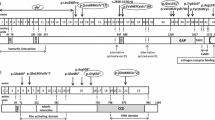Abstract
Although tuberous sclerosis is supposed to be a phacomatosis inherited as an autosomal dominant trait, many cases develop without any affected parents or grandparents. In recent years, many vigorous investigations have been concentrated on finding the mutant gene, and possible candidate genes have been mapped on 9q34 and other chomosomes. In order to find a way of diagnosing asymptomatic carriers or patients, we tried to detect restriction fragment length polymorphisms (RFLPs) using the technique of polymerase chain reaction (PCR). We used a probe, MCOA12, which is located on 9q34 and has been known to show RFLPs in Caucasian tuberous sclerosis patients. However, we could not find a correlation between the phenotype and RFLP pattern in seven of eight families.
Similar content being viewed by others
References
Bundy S, Evans, K (1969) Tuberous sclerosis, a genetic study. J Neurol Neurosurg Psychiatr 32: 591–603
Carlson M, Nakamura Y, Krapcho K, Payson R, O'Connel P, Leppert M, Lathrop GM, Lalouel J-M, White R (1988) Isolation and mapping of a polymorphic DNA sequence (pMCOA12) on chromosome 9q (D9S28). Nucl Acid Res 16: 474
Cassidy SB, Pagon RA, Pepin M, Blumhagen JD (1983) Family studies in tuberous sclerosis. JAMA 149: 1302–1304
Connor JM, Pirrit LA, Yates JRW, Fryer AE, Ferguson-Smith (1987) Linkage of the tuberous sclerosis locus to a DNA polymorphism detected by v-abl. J Med Genet 24: 544–546
Fahsold R, Rott H-D, Lorenz P, Claussen U, Schmalenberger B (1991) In: Abstracts of the Symposium of Tuberous Sclerosis Association of Great Britain
Fryer AE, Chalmers A, Connor JM, Fraser I, Povey S, Yates JRW, Osborne JP (1987) Evidence that the gene for tuberous sclerosis is on chromosome 9. Lancet I: 659–661
Gomez MR (1979) Tuberous sclerosis. Raven Press, New York
Herrman BG, Frischauf A-M (1987) Isolation of genomic DNA. In: Berger LS, Kimmel A (eds) Guide to molecular cloning techniques. Academic Press, San Diego, pp 180–183
Janssen LAJ, Povey S, Attwood J, Sandkuyl LA, Lindhout D, Flodman P, Smith M, Sampson JR, Haines JL, Markens EC, Fleury P, Short P, Amos J, Halley DJJ (1991) A comparative study on genetic heterogeneity in tuberous sclerosis: evidence for one gene on 9q34 and a second gene on 11q22-23. Ann NY Acad Sci 615: 306–315
Kandt MA, Pericak-Vance MA, Hung W-Y, Gardner RJM, Crossn PE, Nellist MD, Speer MC, Roses AD (1991) Linkage studies in tuberous sclerosis — chromosome 9?, 11?, or maybe 14? Ann NY Acad Sci 615: 284–297
Moss C (1991) Dermatology and the human gene map. Br J Dermatol 124: 3–9
Nakauchi Y (1991) Epidemiological observation of tuberous sclerosis in Japan. In: Ishibashi Y, Hori Y (eds) Tuberous sclerosis and neurofibromatosis: epidemiology, pathophysiology, biology and management. Elsevier, Amsterdam, pp 13–21
Saiki RK (1990) Amplification of genomic DNA. In: Innis MA, Gelfand DH, Sninsky JJ, White TJ (eds) PCR protocols: a guide to methods and applications. Academic Press, San Diego, pp 13–20
Smith M, Smalley S, Cantor R, Pandolfo M, Games MI, Baumann R, Yoshiyama K, Nakamura Y, Julier C, Dumars K, Haines J, Trofatter J, Spencer MA, Weeks D, Conneally M (1990) Mapping of a gene determining tuberous sclerosis to human chromosome 11q14-q23. Genomics 6: 105–114
Author information
Authors and Affiliations
Rights and permissions
About this article
Cite this article
Watanabe, R., Ebihara, M., Otsuka, F. et al. Unsuccessful attempt to detect genetic mutation in tuberous sclerosis utilizing the polymerase chain reaction. Arch Dermatol Res 285, 140–143 (1993). https://doi.org/10.1007/BF01112916
Received:
Issue Date:
DOI: https://doi.org/10.1007/BF01112916




